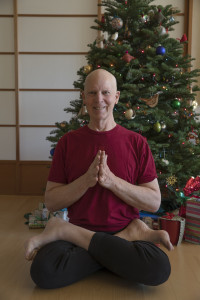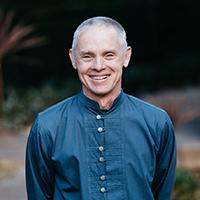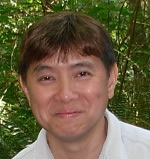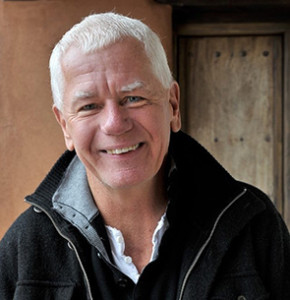Patanjali’s definition of posture, sthira sukham (asanam) desribes the embodied state of being in harmony with both the force of gravity and the natural spaciousness of the Universe. The feeling is that you are floating, which in many ways is true. Internally, there is a release of compression in the blood vessels and nerves, allowing the blood and qi to circulate and flow more freely. This is more easily felt in movement, where the ‘sukham’ or fluid flow through spaciousness is more obvious. In the non-movement of a yoga pose, the sukham is felt as the harmonious flow of blood and qi, even as the outer body remains still. In referring to meditation, Adyashanti describes stillness as the complete absence of resistance to the flow of life. This is another way to describe sthira sukham.
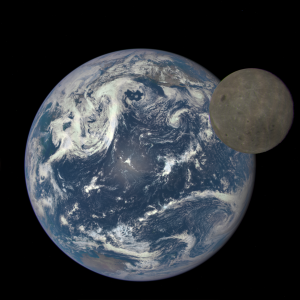 On a cosmic level, all forms in the Universe floating. This NASA photo taken from a million miles away shows our moon gliding past Mother Earth, a big blue ball floating in space. If we look deeply, we can see that not only are we floating, but we are very vulnerable. To us tiny beings on the planet, the earth seems immense. But in a more cosmically oriented reality, it is tiny. Life, and the conditions that allow life are rare, precious and vulnerable in the vast Universe. Covid-19 is here to remind the whole planet of this reality and to encourage us to open our hearts, which know vulnerability intimately, more completely.
On a cosmic level, all forms in the Universe floating. This NASA photo taken from a million miles away shows our moon gliding past Mother Earth, a big blue ball floating in space. If we look deeply, we can see that not only are we floating, but we are very vulnerable. To us tiny beings on the planet, the earth seems immense. But in a more cosmically oriented reality, it is tiny. Life, and the conditions that allow life are rare, precious and vulnerable in the vast Universe. Covid-19 is here to remind the whole planet of this reality and to encourage us to open our hearts, which know vulnerability intimately, more completely.
Vulnerability can lead to deeper opening through an embodied sense of compassion and tenderness. But is also can create the contracting effects of fear and anxiety. This is true both personally and collectively, as we can see in our personal and collective responses to the covid-19 virus. Our responsibility, that is, our ability to respond, to this amazing historical moment, needs to honor the fear appropriately, (social distancing and rigorous hand washing everyone). But we also need to be present to all that arises in the collective field, with compassion and tenderness, to ourselves and others. This is where our practice can hopefully pay off. I remember Iyengar, many years ago, both playfully and seriously describe the need to practice even more diligently when things are going well, quoting the old proverb “make hay while the sun shines”. We’ve been training for this for a while, and now is time to really bring our ‘sthira sukaham‘ vulnerability out into the world, in whatever way we can.
For those new to meditation, ‘vulnerable grounded spaciousness’ is not an easily accessible state of embodiment, as the energetic field holding together the fluids, fibers, organs and tissues of the body carries unresolved and unprocessed wounds and traumas, embedded as patterns of holding and tension. Humans, being expressions of the vulnerability of life, have had to develop survival strategies to remain alive. Implicit in ‘I am vulnerable’ is ‘the world is dangerous’ and ‘I need to defend myself against ‘other”.
Our life experiences, beginning soon after conception, are inevitably filled with moments of pre-verbal fear and anxiety. Continuing through infancy and childhood and on into adulthood, these experiences have the possibility of being resolved and dissolving back into the infinite. However, when very young, even small traumas can overwhelm the immature nervous system and become repressed before they can be resolved. They embed themselves in the tissues as patterns of tension, and remain in the background, unconscious, but influencing our behavior. Over the years, more and more wounds and traumas can accumulate, some being of major intensity.
The ideas and beliefs that evolve along with this survival process create a set of mental processes we call the ego and these become the dominant on-going story of our inner world. (The skandhas are a useful model to describe aspects of this development.) Our innate sense of Wholeness is repressed into the deep unconscious. In the Christian world, this repression is referred to as the “Fall from Grace” or original sin. We all know the feeling of separation and alienation from ourselves, and we are all on the journey back home, awakening to our always and already present Wholeness or True Nature.
Depending on the quality of our parenting, our capacity to self-regulate, and eventually resolve, these internalized states and energetic threats to our vulnerability can range for pretty good to very poor. We all enter adulthood with a some layers of unconsciousness, undigested trauma. Important to note is that the unconscious holds not only our own personal wounds, but also those of our ancestors, passed down through parental patterning, our cultural collective field, and the collective wounds and traumas embedded in the whole human collective unconscious. Meditation practice brings attention to the these unconscious patterns as they arise in the mind field. Awakening, or bringing the light of loving compassionate attention to these layers of the psyche, is what expanding consciousness means. As these traumas arise in our field of awareness, we need skillful means to manage, transform and heal them.
In meditation, when our attention is hijacked by our thoughts, there is usually not a large energetic charge to the process, and we can settle back into some level of stillness relatively easily. However, it is a different story when the hijacking involves trauma. Even outside of mediation, in daily life, we have all had the experience of our attention being hikjacked by some anxiety or fear and feeling the fight or flight mode of survival kick in. Because Covid-19 is activating everyone on the planet and triggering their unconscious, unresolved issues, this is a great time to work on healing both our individual and collective traumas. These powerful energetic states are looking for resolution or transformation, but without conscious skill and attention, we can end up feeding them with more fear energy.
The process of training the nervous system to handle emotional overwhelm is known as self-regulation, and is a primary aspect of parenting, psychotherapy and meditation. A grounded, spacious and loving nervous system can hold the field for another so they can learn to sensibly monitor and modulate their own their own nervous system responses to the moment. A child feels afraid and the parent holds and soothes, allowing her calmness to permeate the nervous system of the child. A therapist remains grounded and calm in their own heart and nervous system, guiding the client to become present, to navigate their inner feelings without being overwhelmed. In meditation, we become a parent to our traumatized inner child, healing ourselves from our own connection to unconditional love.
This is the healing power of the relational field and we can take it out into the world. Not by imposing anything, but by just remaining vulnerable, grounded and spacious as life unfolds around and through us, the collective field is soothed. Of course, the more of us soothing, the more powerful the effect.
The relational field flows both ways of course. Anxiety and fear in the parents also imprint on their children. Demagogues prey upon the fear and anxiety in others to whip up a frenzy of paranoia that they use to further their own ego-driven need for power. This is why we humans, individually and collectively are so emotionally complicated. We often cannot tell where the fear is actually coming from, and thus cannot heal it.
Fear is a healthy expression of our survival instinct. Without it, animal life would not have survived. (Plants do not have nervous systems, so I’m not sure how they internally deal with vulnerability.) Vulnerability is the ultimate expression of life. In the non human world, fear arises in response to a real threat, the nervous system shifts gears and the organism flees, fights or freezes.
Evolution has presented a challenge with the human because we have a nervous system that has evolved to respond to the reality of the present moment. But we have also added new neuronal circuits that can jump back and forth in time, totally losing track of the present moment, and confusing the older structures. The human mind can conjure up fear when there is no danger at all in the present and the flight or flight response triggers. We can project an imaginary scary future and get all contracted inside, now. Or something triggers a chunk of stored, undigested fear or anxiety, stored in the body, and we feel terrified as if there is a real threat happening now. When a real threat like covid-19 appears, we often over-react because the unresolved fears of the past also flood the system, and it is unclear what responses are appropriate and which ones are not. We can act ir-response-ibly when emotionally confused.
Practice
In your sitting practice, or even when standing and walking, take time to trace the flow of gravity downward, allowing your attention/imagination to travel all the way through, to the other side of the earth and beyond. Notice that you end up moving into space. If you really allow the earth to hold you, spaciousness spontaneously arises as a natural expression of the cosmic order. This is sthira sukham, or grounded spaciousness. Begin to notice that all the non-human beings on our planet are continuously expressing sthira sukham. Time for us to join the party.
However, as wonderful and important as this is, this is still a grounded-ness in the world of form. It leads to a relaxing and opening in the nervous system and this can be a portal to true stability, or should I write True Stability, which is Self Realization, or total identification with the Ground of Being, or True Nature. Nothing more stable than the ‘unchanging unbounded Presence. This is why True Meditation is so important.
True Nature, ever-present and yet hidden, cannot not be discovered through thought. We have to feel our way down and in, through the layers of our psyche, into the unknown. Thought can only regurgitate what it already knows. It knows not of the unknown. When we can create some level of outer silence, to eliminate distraction, and our attention can turn inward, thoughts and emotions throw up more distractions. They are neither good nor bad, just distractions. Practice is patiently allow these distractions to come and go without reacting.
The habitual grasping and avoiding really want to do their thing, but we can develop patience by training the mind to stabilize on a seed form, (see previous post). As the seed matures and takes on a life of its own, holding the energy field of the body/mind in a state of integrated coherence, we can feel/listen even more deeply and allow True Nature to reveal itself. Awakening cannot be willed, but received, as Divine Grace. As Richard Baker Roshi, one time head of the San Francisco Zen Center once said, ‘Awakening is an accident, but practice makes you accident prone.”
Keep practicing !
Addendum to the previous post: More Japa:
OM
the ultimate mantra
Pause – Relax – Open – Allow
From Frank Ostaseski. any and/or all of the words work
Metta Phrases: Feel free to use ones that have the most meaning for you.
May I (We) be safe.
May we be healthy.
May we be happy.
May we be filled with loving kindness


